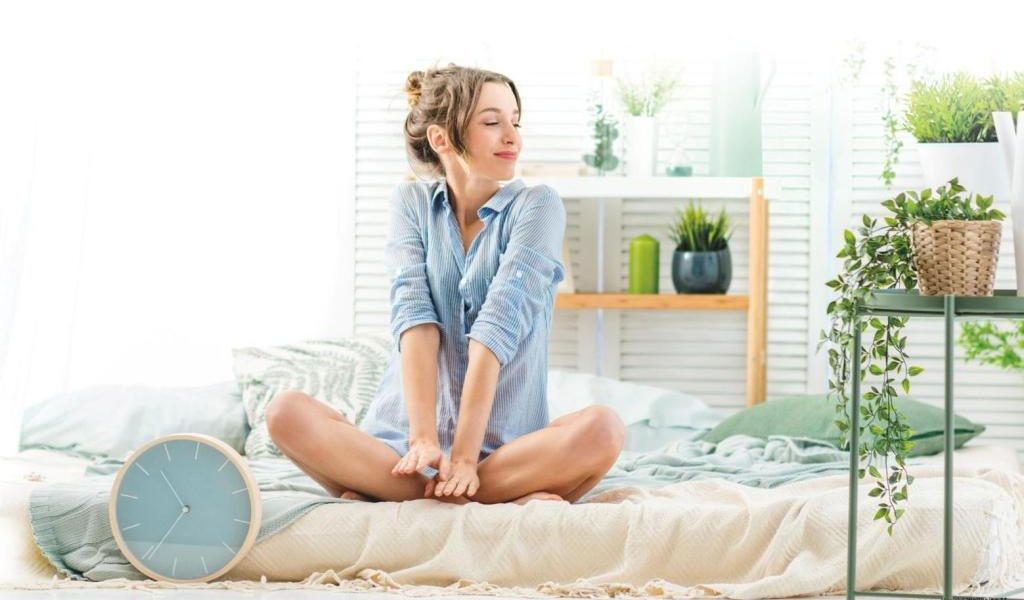Trying to be more environmentallyfriendly, but not sure where to start? Whether it’s new recycling rules from your local council or David Attenborough advising us to use less plastic, we all know that it’s important to be aware of the effect we’re having on the environment. However, it can feel rather overwhelming, with the lifestyle changes required appearing nigh on impossible. But, worry not! We’ve compiled an easy guide to help you be more eco-friendly in every room of your house – and it could save you almost £500 a year!
In your bedroom
Turn it into a space of peace and rest with some easy fixes, without compromising on style or comfort. Firstly, consider your mattress. Did you know that 73 percent of them are sent to landfill? As we’re supposed to change our mattresses every eight years (according to a well-known retailer), that’s a lot of waste being created. There are lots of brands that now offer 100 percent recyclable versions – try Button & Sprung (buttonandsprung.com), which uses wool, or Silentnight’s new Eco Comfort Collection (silentnight.co.uk), made from recycled plastic bottles. Need more ideas? Switching to woollen bedding is not only a great eco-friendly choice, it could also improve your quality of shut-eye. A study by the University of Sydney found that, because wool breathes better than synthetic materials, it increases periods of REM slumber and gets your body to a comfortable sleeping temperature faster. Sweet dreams!
In your utility room
“Line drying is the best way to dry your clothes – the sun naturally whitens while the air will deodorise,” says Sarah Turner, founder of Little Beau Sheep (littlebeausheep.com). “When you do need to use the tumble dryer, plan a laundry day. Only use your washing machine on a full load to save energy and always sort your clothesy by colour and fabric for best results. Dry loads, one after the another, to utilise the heat from the previous load. Cut out fabric softeners and dryer sheets, as they add unnecessary chemicals and create waste – essential oils on a dryer ball can be used instead to add a natural fragrance. Before you throw an item in the machine, ask yourself if it actually needs a wash. Obviously, this doesn’t apply to undergarments! But items worn with underwear, such as jumpers and jeans, can be worn a few times before washing, if they haven’t been soiled. This not only saves energy but prolongs the life of the garment, too. Hanging clothes up to air between wears also keeps them looking good.”
In your bathroom
“By now, most of us are aware of the impact single-use plastics have on our planet, so it’s best to look for cosmetics packaged in reusable (and prettier) glass bottles and jars where possible,” advises Viola Radomsky, founder of beauty brand Lani (lovelani.com). This is especially important as recent research by Recycle Now (recyclenow.com) has revealed that while nine in 10 of us recycle our kitchen waste, four in 10 admit they don’t do the same in the bathroom. Simply hanging a bag on the back of the door will serve as a reminder to not throw things in the general waste bin when you do find yourself with an empty plastic container.
Got a leaky toilet or tap? Fixing issues like this as soon as they occur will help save water – a continuously running toilet can waste as much as 60,000 litres a year – and lower your bill at the same time. Choosing a more efficient shower head and a dual flush loo can also help you make big savings.
One thing you might not have considered is your menstrual cycle, but it’s definitely worth thinking about. For example, did you know that 200,000 tonnes of sanitary products a year end up in UK landfill, and, shockingly, they are the fifth most common item found on Europe’s beaches. Luckily though, there are solutions to reduce plastic waste. You can try items including reusable tampon applicators, menstrual cups and period briefs which absorb blood, such as those available from WUKA. In fact, just one pair of WUKA briefs can prevent over 200 disposables from going to landfill!
In your living room
Try decorating your space with house plants – not only do these make timeless, statement features, they also bring big benefits. Indoor air pollutants have been ranked among the top five environmental risks to public health but, luckily, greenery has been shown to clean the air because it absorbs harmful chemicals. As we now spend a shocking 90 percent of our time indoors, it’s well worth your time investing in plants to ensure that the air quality is the best it can be. Unsure of how many to buy? If you live in a one-, or two-bed flat, you should aim for at least six, while a large two-, or three-bed terrace could accommodate at least 11 plants for A-grade air purifying benefits. There are plenty of options – choose anything from a retro spider plant to a stunning peace lily, or even the striking, hard-tokill mother-in-law’s tongue, which can even grow in spaces with low light.
In your kitchen
While there are lots of obvious ways to be more eco-friendly in your kitchen – such as avoiding single-use plastic and reducing food waste – there are some that you might not have considered. One good example is to always know what you’re looking for before opening the fridge door. This might not seem like a big deal, but that open door is responsible for seven percent of the appliance’s total energy usage, as it has to work harder to keep cool thanks to the warmer air you’ve let in. In fact, according to research by the University of Florida, being careless with the fridge door wastes 50 to 120kWh a year – that’s enough to run your washing machine a staggering 50 times.
Easy ways to be eco-friendly
- Switch off the lights when you’re not using a room. Yes, it may sound simple and it’s easy to forget to do this, but it costs nothing and could save you around £15 on your energy bill a year.
- Change your old halogen light bulbs to LED alternatives – they can use up to 90 percent less energy and could reduce your yearly bill by around £100!
- On average, 47 percent of heat loss occurs through the walls of our houses, so ensuring that you have suitable cavity wall insulation could save up to £250 a year on heating.
- Always leave your TV on standby? Not turning off your devices at the wall costs you between £45 to £80 a year, as well as wasting electricity.
- lf you’re fed up of constant junk mail, there are some ways to opt out of receiving unaddressed post. Register online on the Mail Preference Service (mpsonling.org.uk) to remove your details from mailing lists – while this isn’t 100 percent effective, it still goes a long way into reducing paper waste.



















